挪威船级社近海箱标准DNV 2-7-1讲解
211127350_挪威船级社CLEAN(DESIGN)_的标准要求及其在集装箱船轮机设计上的应用

挪威船级社CLEAN(DESIGN)的标准要求及其 在集装箱船轮机设计上的应用姚 飞1 董 越1 李 华2 段玉龙1 马天帅3(1. 中国船舶及海洋工程设计研究院 上海 200011; 2. 中国船级社江苏分社 南京 210011; 3. 海装装备项目管理中心 北京 100071)摘 要:…随着海洋环境保护的要求日益严格,各主要船级社均提出了自己的环保船级符号。
DNVGL的CLEAN…(DESIGN)…附加符号为船舶的设计、操作和设备设定相关要求,以减少排放到空气中和海洋中以及从船舶运送到岸上的有害物质对环境的影响。
CLEAN(DESIGN)是DNVGL规范中较为严格的环保符号,在近几年的集装箱船设计中鲜有应用。
某型双燃料集装箱船是取得CLEAN(DESIGN)符号的绿色船舶,在研发过程中突破了一系列设计要点,包括机舱液舱布置、生活污水处理、燃油舱保护等,达到了集装箱运输船绿色环保的新高度。
该文系统总结了CLEAN(DESIGN)符号对集装箱船轮机设计的要求,研究了该符号对集装箱运输船轮机设计的影响,结合实际项目展示了实船的设计思路和方案,提出了进一步提升集装箱运输船绿色环保水平的措施。
关键词:集装箱船;船级符号;CLEAN(DESIGN);轮机设计中图分类号:U662.1;U674.13+1………文献标志码:A………DOI:10.19423/ki.31-1561/u.2023.02.088 Standard Requirements of DNVGL CLEAN(DESIGN)and Application in Machinery Design for Container Vessel YAO Fei1 DONG Yue1 LI Hua2 DUAN Yulong1 MA Tianshuai3(1. Marine Design & Research Institute of China, Shanghai 200011, China;…2. China Classification Society Jiangsu Branch, Nanjing 210011, China;…3. Marine Equipment Project Management Center, Beijing 100071, China)Abstract: With the increasingly stringent requirements of marine environmental protection, all major classification societies have proposed their own environmental protection class notations. Among them, the additional class notation of DNVGL CLEAN(DESIGN)additional notation sets requirements for the design, operation and equipment of ships to reduce the ship’s environmental impact from air emissions, sea discharges and hazardous materials from ship to shore. The environmental notation CLEAN(DESIGN)is quite stringent in the DNVGL rules, which is rarely used in the design of container vessels in recent years. A dual-fuel container vessel is a green ship that has the notation CLEAN(DESIGN). In the process of research and development, the container vessel has broken through a series of design essentials, such as the arrangement of engine room and liquid tanks, sewage treatment and fuel tank protection, reaching a new level of green environmental protection for container vessels. This article systematically summarizes the requirements of CLEAN(DESIGN)notation for the machinery design of container vessels, and studies the influence of this notation on the machinery design of container vessels.收稿日期:2022-09-01;修回日期:…2022-09-27作者简介:姚…………飞(1993-),男,硕士,助理工程师。
挪威船级社规范(DNV)2005

挪威船级社船板规范(DNV:2005)第二部分第二章第一节结构用轧制钢材A通则A100 适用范围101本节规定了可焊接普通强度、高强度和超高强度结构用轧制钢板和型钢的要求,这些要求也适用于结构用无缝钢管。
本要求适用于厚度不超过150mm的钢材产品。
对于更厚的钢材按每一情况考虑后可接受或要求与本规范有某些不同的规定。
本节包含了IACS UR W11和W16的规定。
对用轧制扁坯、方坯或圆钢作为锻件代替品的要求见第5节。
102在化学成分、脱氧方法、供货状态和机械性能与本规范要求有所不同的钢材,只要经本船级社专门认可也可予以接受。
这些钢材应给予特殊符号,见200。
A200 钢材等级符号201本节钢材等级按强度等级划分为三组----普通强度钢(NS)----高强度钢(HS)----超强度钢(EHS)202钢材等级的字母数字标记为NV xy。
其中:NV—按本社规范规定的钢材等级符号X—大写字母表示的相应于规定的冲击试验温度,见表A1。
Y—按标定最小屈服强度确定的强度组别数字符号,见表A1。
对NS钢该数字可省略。
203在202规定的字母数字符号后的附加符号可以是:Z—改进厚度方向性能的钢材等级。
S—专门认可的钢材,见100。
A300制造方法301钢用碱性吹氧炼钢工艺、电炉工艺生产,经本社批准,也可用其它方法生产。
302从连续浇铸的扁坯轧成板材的板厚减薄率除非本社另行认可,最小值为5:1。
303适用的轧制方法定义如下:控制轧制CR(正火轧制NR):在正火温度范围内进行的最终成型的轧制过程。
所得到的材质状态,通常相当于经正火后的结果。
热机轧制TM(热机控制法TMCP):这是一种必须严格控制钢材温度和轧制减薄量的方法。
通常在接近AR3温度下实施高比例的轧制减薄量,并可在两相区域内进行轧制。
不同于控制轧制法(正火轧制),TM具有的性能不可能由随后的正火或其他热处理方法再生产。
B普通强度钢B100适用范围101本条规定了普通强度钢的要求,最小屈服强度为235N/mm2的钢材定为普通强度钢。
dnv规范
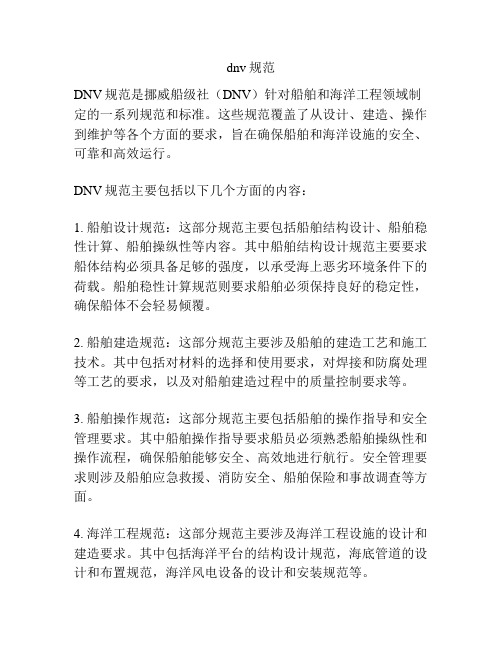
dnv规范
DNV规范是挪威船级社(DNV)针对船舶和海洋工程领域制定的一系列规范和标准。
这些规范覆盖了从设计、建造、操作到维护等各个方面的要求,旨在确保船舶和海洋设施的安全、可靠和高效运行。
DNV规范主要包括以下几个方面的内容:
1. 船舶设计规范:这部分规范主要包括船舶结构设计、船舶稳性计算、船舶操纵性等内容。
其中船舶结构设计规范主要要求船体结构必须具备足够的强度,以承受海上恶劣环境条件下的荷载。
船舶稳性计算规范则要求船舶必须保持良好的稳定性,确保船体不会轻易倾覆。
2. 船舶建造规范:这部分规范主要涉及船舶的建造工艺和施工技术。
其中包括对材料的选择和使用要求,对焊接和防腐处理等工艺的要求,以及对船舶建造过程中的质量控制要求等。
3. 船舶操作规范:这部分规范主要包括船舶的操作指导和安全管理要求。
其中船舶操作指导要求船员必须熟悉船舶操纵性和操作流程,确保船舶能够安全、高效地进行航行。
安全管理要求则涉及船舶应急救援、消防安全、船舶保险和事故调查等方面。
4. 海洋工程规范:这部分规范主要涉及海洋工程设施的设计和建造要求。
其中包括海洋平台的结构设计规范,海底管道的设计和布置规范,海洋风电设备的设计和安装规范等。
总之,DNV规范是船舶和海洋工程领域的重要标准,它不仅
涵盖了船舶和海洋工程设施的设计、建造、操作等方面的要求,更重要的是,它为保障船舶和海洋设施的安全和可靠运行提供了一系列具体的指导和标准。
同时,DNV规范的持续更新和
改进也为船舶和海洋工程行业的发展提供了重要支持。
挪威船级社
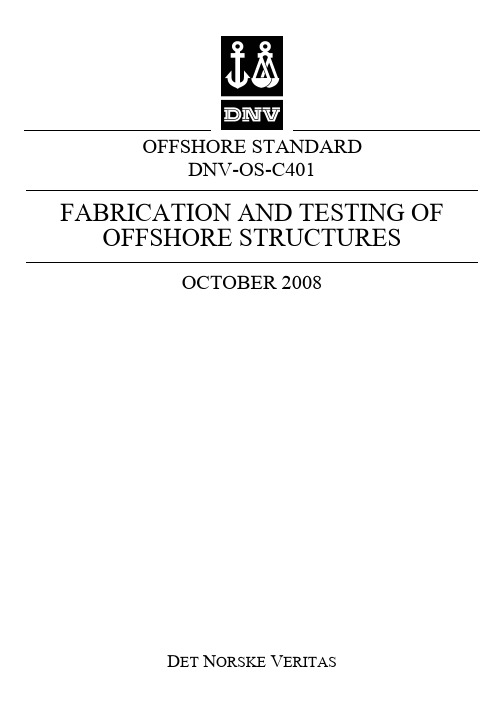
For an overview of all types of DNV offshore documents and their update status, see the “Amendments and Corrections” document located at: /global/, under category “Offshore Codes”.
Sec. 1 Introduction........................................................... 9
A. General.................................................................................... 9 A 100 Introduction....................................................................... 9 A 200 Objective........................................................................... 9 A 300 Organisation of contents ................................................... 9
Offshore Service Specifications and Offshore Standards. DNV Offshore Codes are offered within the following areas: A) Qualification, Quality and Safety Methodology B) Materials Technology C) Structures D) Systems E) Special Facilities F) Pipelines and Risers G) Asset Operation H) Marine Operations J) Wind Turbines O) Subsea Systems
DNV挪威船级社规范中文 精编金属材料
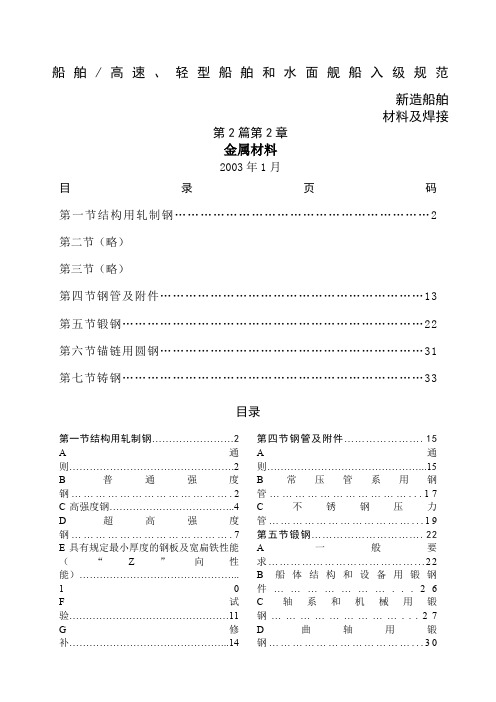
船舶/高速、轻型船舶和水面舰船入级规范新造船舶材料及焊接第2篇第2章金属材料2003年1月目录页码第一节结构用轧制钢 (2)第二节(略)第三节(略)第四节钢管及附件 (13)第五节锻钢 (22)第六节锚链用圆钢 (31)第七节铸钢 (33)目录第一节结构用轧制钢 (2)A通则 (2)B普通强度钢 (2)C高强度钢 (4)D超高强度钢 (7)E具有规定最小厚度的钢板及宽扁铁性能(“Z”向性能)………………………………………...10 F试验 (11)G修补................................................14 第四节钢管及附件. (15)A通则 (15)B常压管系用钢管 (17)C不锈钢压力管 (19)第五节锻钢 (22)A一般要求 (22)B船体结构和设备用锻钢件........................2 6 C轴系和机械用锻钢 (27)D曲轴用锻钢 (30)第六节锚链用圆钢 (31)A通则 (3)1B试验 (3)2 C材料标记 (32)第七节锻钢件 (33)A一般要求 (33)B船体结构和设备用铸钢 (36)第一节结构用轧制钢材A总则A100适用范围101本节规定了可焊普通强度、高强度、超高强度结构用热轧钢板和型材的要求,这些要求也适用于结构用无缝钢管。
本要求适用于厚度不超过150mm的钢材产品,对于更厚的钢材,按每种情况经考虑后可接受或要求与本规定有某些不同的规定。
本节包括了IACSURW11和W16。
对轧制扁坯、方坯或圆钢作为锻件代用品要求见第5节。
102经本船级社特许,在化学成份、脱氧方法、供应状态和机械性能方面与本规范要求有所有同的钢材也可接受。
这类钢材给予特殊符号,见200。
A200钢材等级符号201本节钢材等级按强度等级划分为三组:---普通强度钢(NS)---高强度钢(HS)---超高强度钢(EHS)202钢材等级的字母数字标记为NVxy,其中:NV=按本社规范规定的钢材等级符号。
DNV_2.7.1_2006--集装箱

DNV近海集装箱标准2.7-104/20061.总则1.1范围此认证标准适用于涉及设计,制造,试验,认证,标识和定期检验的用于运输的近海集装箱的相关要求。
此标准覆盖了集装箱的结构和用于操作,装卸,制冷,加热和安全目的的永久设备。
其目的是为了使近海集装箱必须满足如下要求:使用安全,与如下有关:生命环境对船舶和海上设施的潜在危险通过如下选择使其能够重复使用:材料防护便于维修和保养此标准的要求基于近海集装箱的一系列有关操作和使用的假设:他们是被起重机吊钩从其顶部吊装设置单独起吊他们不用排架起吊或使用ISO角件他们能被任何具备充分能力和速度的起重机在世界上任何地方起吊对于限制使用区域(温度气候)的集装箱的认可看附录3他们只有被设计成可堆码时才可以被堆码他们只可以被堆在近海和岸上设施上而不能在运输过程中被堆在船舶上货物或松散设备应被固定在箱子上集装箱必须被设计成能够对其装载的货物和设备提供充分的保护他们按照IMO’S‘支持船安全操作守则’操作按当地法规操作船级社可以批准能够找到的,在总体安全性方面相当于本标准的替代标准。
如果有充分的信息表明已选择的替代标准不满意时这种批准可以取消。
当本标准所用的词‘集装箱’时,其指‘近海集装箱’。
本标准的指引部分和注解部分不作为DNV的要求,只作为设计者和操作者的实用建议和信息。
本标准常常直接参考各种标准(EN,ISO等),或者参考其他得到承认的标准,得到承认的标准意思是该标准得到船级社的接受。
1.2与其他标准,条例和惯例的关系1.2.1国际海事组织(IMO)IMO已经颁布了国际集装箱安全公约CSC和国际海运危险货物规则IMDG。
这两种为强制的国际惯例。
IMO承认的CSC公约不能直接应用于在海上操作的近海集装箱,IMO还发布了MSC/CIRC.860通函用于近海集装箱认证的指导性文件。
IMDG规则同时要求在开阔海面上操作的集装箱和移动罐柜应该依此目的得到认可。
按此标准认可的集装箱同时满足MSC/CIRC.860,此点应在证书上提及。
DNV挪威船级社船规

船舶入级规范新造船舶材料与焊接第二篇第二章金属材料2001年1月目录第一节结构用轧制钢材第二节锅炉、压力容器以及特殊用途轧制钢材第三节复合钢板第四节钢管及附件第五节锻钢件第六节锚链用圆钢第七节铸钢件第八节铸铁件第九节铝合金第十节铜合金第十一节耐热有色合金目录第1节结构用轧制钢材A.通则A 100适用范围A 200钢材等级符号A 300制造方法B.普通强度钢B 100适用范围B 200化学成分B 300热处理、供应状态B 400机械性能C.高强度钢C 100适用范围C 200化学成分C 300热处理、供应状态C 400机械性能D.超高强度钢D 100适用范围D 200化学成分D 300热处理、供应状态D 400机械性能E.试验E 100试验材料E 200拉力试验E 300冲击试验E 400厚度方向性能试验E 500检验-容差F.修补F 100表面缺陷第2节锅炉、压力容器以及特殊用途轧制钢材A.通则A 100适用范围A 200制造方法B.锅炉和受压容器用钢B 100钢材等级B 200化学成分B 300机械性能B 400热处理C.低温用钢C 100钢材等级C 200化学成分C 300机械性能C 400热处理D.不锈钢D 100钢材等级D 200化学成分D 300机械性能D 400热处理D 500晶间腐蚀倾向试验E.试验E 100一般要求E 200常温下的拉力试验E 300高温下的拉力试验E 400冲击试验E 500落锤试验E 600厚度方向性能试验E 700晶间腐蚀倾向试验F.检验、尺寸容差和表面状态F 100检验F 200容差F 300表面状态和缺陷修整第3节复合钢板A.通则A 100适用范围A 200热处理B.基体材料B 100一般规定C.包覆金属C 100一般规定C 200化学成分D.试验D 100一般规定D 200拉力试验D 300冲击试验D 400弯曲试验D 500剪切试验D 600超声波试验D 700腐蚀试验D 800检验-容差E.修补和拒收E 100表面缺陷E 200拒收F.材料的标记F 100标记第4节钢管A.通则A 100适用范围A 200制造A 300质量A 400尺寸的容差A 500化学成分A 600热处理A 700机械性能A 800试验材料A 900外观检查和无损探伤A 1000液压试验A 1100重复试验A 1200标记A 1300证书B.常压管系用钢管B 100适用范围B 200制造B 300化学成分B 400热处理B500机械性能C.不锈钢压力管C 100适用范围C200制造C 300化学成分C 400热处理C 500机械性能C 600腐蚀试验D.低温用钢管D 100适用范围D200制造D 300化学成分D 400热处理D 500机械性能E.锅炉、热交换器和过热器用钢管E 100适用范围E 200制造E 300化学成分E 400热处理E 500机械性能F.附件F 100适用范围F 200材料F 300制造F 400热处理F 500机械性能F 600 硬度试验F 700 腐蚀试验F 800 表面光洁度和尺寸F 900印记和证书第5节锻钢件A.通则A 100适用范围A 200制造A 300质量A 400化学成分A 500热处理A 600 试块A 700常温下的机械试验A 800高温下的拉力试验A 900重复试验A 1000外观检查和无损探伤A 1100 缺陷锻件的修整A 1200证书B、一般用途锻钢件B 100适用范围B 200钢材类型B 300化学成分B 400热处理B500试块和机械性能C、轴系和机械锻钢件C 100适用范围C 200钢材类型C 300化学成分C 400热处理C 500试块C 600机械性能D、齿轮锻钢件D 100适用范围D 200制造D 300化学成分D 400热处理D 500正火加回火和淬火加回火锻件的试验材料D 600用于渗碳和硬化处理锻件的试验材料D 700机械性能E、锅炉、非点火的压力容器和机械管系锻钢件E 100适用范围E 200化学成分E 300热处理E 400 试验材料E 500机械性能F、裸露于低温的液货舱、压力容器和管系用锻钢件F 100适用范围F 200钢材类型F 300化学成分F 400热处理F 500试验材料F 600机械性能第6节锚链用圆钢A 100适用范围A 200钢的等级A 300化学成分A 400机械性能A 500 热处理B、试验B 100试验数量B 200冲击试验C、材料标记C 100印记第7节铸钢件A 100适用范围A 200铸造A 300铸件质量A 400化学成分B 100钢的类型B 200化学成分B 300机械性能C、锅炉、非点火的压力容器和机械管系铸钢件C 100钢的类型C 200化学成分C 300机械性能D、螺旋桨铸钢件D 100钢的类型D 200机械性能E、锚链环、附件、锚卸扣用的铸钢件E 100锚链环E 200锚链附件和锚卸扣F、有高韧性要求的结构构件用的铸钢件F 100钢的类型F 200化学成分F 300机械性能G、液化气系统用的铸钢件G 100钢的类型G 200化学成分G 300机械性能H、热处理H 100一般要求H 200碳钢和碳锰钢的热处理H 300低合金钢的热处理H 400不锈钢的热处理I、试验I 100试样I 200高温下的机械试验I 300高温下的拉力试验I 400液压试验I 500外观检查和无损探伤J、有缺陷铸件的修整J 100补焊K、结构构件的焊接K 100一般要求第8节铸铁件A 100适用范围A 200 铸件质量A 300制造A 400化学成分A 500热处理A 600试验A 700外观检查和无损探伤A 800缺陷修补B、球墨铸铁B 100 适用范围B 200试验材料B 300机械性能B 400金相检验C、灰铸铁C 100 适用范围C 200试验材料C 300机械性能第9节熟铝合金A、通则A 100适用范围A 200铝材等级A 300化学成分A 400回火符号A 500机械性能B、试验B 100试样B 200拉力试验B 300其他试验B 400检验、容差C、缺陷修补C 100一般要求D、材料标记D 100标记第10节铜合金A、通则A 100适用范围B、阀件、附件和一般用途的铸件B 100铜合金类型B 200化学成分B 300机械性能B 400试验C、螺旋桨铸件C 100化学成分C 200机械性能C 300热处理C 400试验和检验C 500缺陷修补D、管材D 100化学成分D 200机械性能D 300热处理D 400试验第11节耐热有色合金A、通则A 100适用范围A 200认可A 300热处理B、试验B 100试样B 200拉力试验B 300冲击试验B 400蠕变和断裂试验B 500无损探伤试验B 600其他试验第一节结构用轧制钢材A.通则A 100 适用范围101 本节规定了可焊普通强度、高强度和超高强度结构用热轧钢板和型材的要求,这些要求也适用于结构用无缝钢管。
挪威船级社安全及质量认证

挪威船级社安全及质量认证挪威船级社(Det Norske Veritas,简称DNV)成立于1864年,总部位于挪威首都奥斯陆,是一个权威,专业,独立的非赢利性基金组织。
在“保护生命,财产与环境”的宗旨下,DNV 为客户提供全面的风险管理和各类评估认证服务,主要涉及船级服务,认证服务,技术服务等方面。
DNV在全球130个国家中设立了330多个分支机构,目前员工数目已超过6500人。
DNV是世界最知名的船级社和国际权威认证机构,为各类组织提供高质量的专业服务。
挪威船级社国际安全认证系统ISRS7星-最高等级国际安全评级系统(ISRS):此评价方法于1974年由美国国际损失控制院所开发,后来由挪威船级社(DNV)所拥有并持续开发。
国际安全评级系统(ISRS)在过去30年里已经在许多行业中应用,其中25%的世界500强企业均采用此评价方法,并获得了国际大企业的一致好评国际安全评分系统(ISRS)是什么?国际安全评分系统是现今最好的管理工具,这个系统可以客观地评估及测量一间公司及健康计划所作的努力。
并评估该公司的整体安全水平。
良好安全水平为等级7或8。
此评价成果可用于以下几个方面: 了解公司安全及健康管理与措施的真正安全水平;与其它类似企业安全管理水平作个实际比较(Bench marking);点出公司安全及健康管理与措施的薄弱环节;提出进一步改善公司安全及健康管理的措施;跟进后续整改状况及观察真正的安全水平提升等。
ISRS是一套以行为方式基础的系统,从管理结构和审核规程组成,此系统分为二十个单元。
在安全及健康管理上,ISRS是一套有效及十分普遍的系统。
这个系统不单是良好的管理常规,而且可以作为实施、维持及改善安全与健康策略的指引。
国际安全评分系统之计划单元领导与管理领导人员训练定期检查及维修关键作业分析及步骤事故调查工作观察紧急应变布置作业规章及工作许可证事故分析知识及技能训练个人防护工具健康及卫生管理评估系统工程及转变管理个人沟通小组会议一般宣传雇用及配工物料及服务管理下班后安全挪威船级社的国际质量评价系统IQRS-6级(最高级)。
DNV2.7-1标准
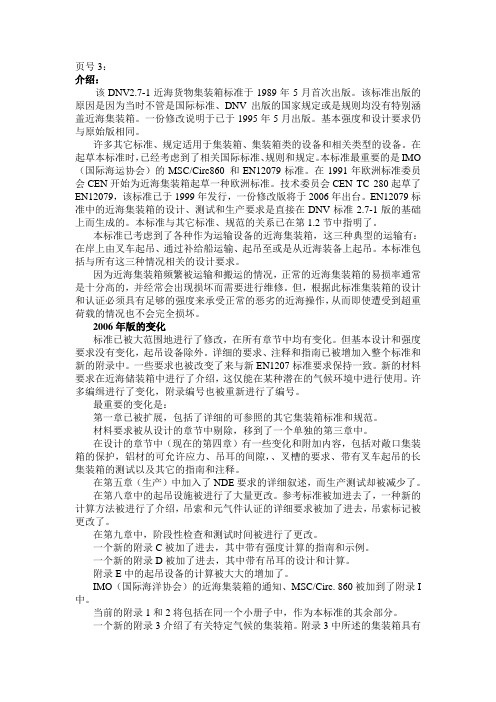
页号3:介绍:该DNV2.7-1近海货物集装箱标准于1989年5月首次出版。
该标准出版的原因是因为当时不管是国际标准、DNV出版的国家规定或是规则均没有特别涵盖近海集装箱。
一份修改说明于已于1995年5月出版。
基本强度和设计要求仍与原始版相同。
许多其它标准、规定适用于集装箱、集装箱类的设备和相关类型的设备。
在起草本标准时,已经考虑到了相关国际标准、规则和规定。
本标准最重要的是IMO (国际海运协会)的MSC/Circ860 和EN12079标准。
在1991年欧洲标准委员会CEN开始为近海集装箱起草一种欧洲标准。
技术委员会CEN TC 280起草了EN12079,该标准已于1999年发行,一份修改版将于2006年出台。
EN12079标准中的近海集装箱的设计、测试和生产要求是直接在DNV标准2.7-1版的基础上而生成的。
本标准与其它标准、规范的关系已在第1.2节中指明了。
本标准已考虑到了各种作为运输设备的近海集装箱,这三种典型的运输有:在岸上由叉车起吊、通过补给船运输、起吊至或是从近海装备上起吊。
本标准包括与所有这三种情况相关的设计要求。
因为近海集装箱频繁被运输和搬运的情况,正常的近海集装箱的易损率通常是十分高的,并经常会出现损坏而需要进行维修。
但,根据此标准集装箱的设计和认证必须具有足够的强度来承受正常的恶劣的近海操作,从而即使遭受到超重荷载的情况也不会完全损坏。
2006年版的变化标准已被大范围地进行了修改,在所有章节中均有变化。
但基本设计和强度要求没有变化,起吊设备除外。
详细的要求、注释和指南已被增加入整个标准和新的附录中。
一些要求也被改变了来与新EN1207标准要求保持一致。
新的材料要求在近海储装箱中进行了介绍,这仅能在某种潜在的气候环境中进行使用。
许多编缉进行了变化,附录编号也被重新进行了编号。
最重要的变化是:第一章已被扩展,包括了详细的可参照的其它集装箱标准和规范。
材料要求被从设计的章节中剔除,移到了一个单独的第三章中。
DNV_271_2006--集装箱
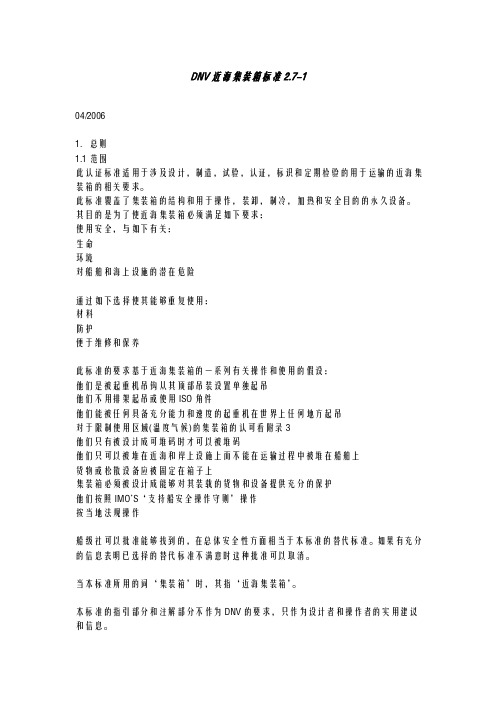
DNV近海集装箱标准2.7-104/20061.总则1.1范围此认证标准适用于涉及设计,制造,试验,认证,标识和定期检验的用于运输的近海集装箱的相关要求。
此标准覆盖了集装箱的结极和用于操作,装卸,制冷,加热和安全目的的永久设备。
其目的是为了使近海集装箱必须满足如下要求:使用安全,与如下有关:生命环境对船舶和海上设施的潜在危险通过如下选择使其能够重复使用:材料防护便于维修和保养此标准的要求基于近海集装箱的一系列有关操作和使用的假设:他们是被起重机吊钩从其顶部吊装设置单独起吊他们不用排架起吊或使用ISO角件他们能被仸何具备充分能力和速度的起重机在世界上仸何地方起吊对于限制使用区域(温度气候)的集装箱的认可看附彔3他们只有被设计成可堆码时才可以被堆码他们只可以被堆在近海和岸上设施上而不能在运输过程中被堆在船舶上货物或松散设备应被固定在箱子上集装箱必须被设计成能够对其装载的货物和设备提供充分的保护他们按照IMO’S‘支持船安全操作守则’操作按当地法规操作船级社可以批准能够找到的,在总体安全性方面相当于本标准的替代标准。
如果有充分的信息表明已选择的替代标准不满意时这种批准可以取消。
当本标准所用的词‘集装箱’时,其挃‘近海集装箱’。
本标准的挃引部分和注解部分不作为DNV的要求,只作为设计者和操作者的实用建议和信息。
本标准常常直接参考各种标准(EN,ISO等),或者参考其他得到承认的标准,得到承认的标准意思是该标准得到船级社的接受。
1.2与其他标准,条例和惯例的关系1.2.1国际海事组织(IMO)IMO已经颁布了国际集装箱安全公约CSC和国际海运危险货物规则IMDG。
这两种为强制的国际惯例。
IMO承认的CSC公约不能直接应用于在海上操作的近海集装箱,IMO还収布了MSC/CIRC.860通函用于近海集装箱认证的挃导性文件。
IMDG规则同时要求在开阔海面上操作的集装箱和移动罐柜应该依此目的得到认可。
按此标准认可的集装箱同时满足MSC/CIRC.860,此点应在证书上提及。
DNV挪威船级社规范中文版
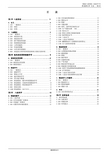
第2节 规范的范围和船级符号 ................. 8
A. 规范的应用 规范的应用范围 应用范围 ............................... 8 A 100 一般要求 .................................. 8 A 200 规范的应用范围 ............................. 8 A 300 规范的要点 ................................ 8 B. 船级符号 ................................ ..................................... ..... 9 B 100 一般要求 .................................. 9 B 200 建造符号 .................................. 9 B 300 船级主字符 ............................... 9 B 400 航区船级符号 .............................. 9 B 500 其它航行限制 .............................. 9 B 600 附加船级: 服务和类型船级符号 ............. 9 B 700 附加船级: 设备和系统船级符号 .............. 12 B 800 附加船级: 特征船级符号 .................... 14 B 900 国家法规 .................................. 14 B 1000 附加船级: NAUTICUS ........................ 14
的服务范围,且涉及: — 无论是新建造的或营运船舶的入级; — 代表国家海事主管机关执行的法定检验工作; — 船用设备和材料。
DNV-OS-F01 2007中文版

生产工艺规范(MPS)
601 生产开始前,制造厂应制定一份生产工艺规范(MPS) 。MPS 应证明在整个提议的制造工 序中如何达到和验证规定的性能。 MPS 应指出所有影响产品质量和一致性的因素,并对从来料控制到成品钢管发运的所有主 要生产步骤,包括所有检验和检查点,进行详细的概述。 应包含对执行所有个别生产步骤所建立的参考程序。 602 MPS 至少应包含以下信息(如适用) : — 炼钢厂
海洋标准 DNV-OS-F101
海底管线系统
2007 年 10 月
挪威船级社
第7节 建筑—管线钢管
A.概述
A100 目的 101 本节规定了管线钢管生产、试验和文件证明的要求。在热处理、扩径和最终成型后应达到 所有的力学性能和尺寸公差。 102 管材选择应按照第 6 节进行。 103 本节不包括钢管从管厂发运后的任何行为,例如环焊和防腐。 104 在此对碳锰(C-Mn)钢管线钢管的要求在大体上符合 ISO 3183 附录 J:“海洋服役条件下 PSL 2 钢管”,并对其进行了一些补充和变更。 105 管线钢管制造厂应有一套执行的质量保证体系符合 ISO 9001。 A200 应用 201 这些要求适用于以下材质的管线钢管: — C-Mn 钢 — 复合或衬套钢 — 防腐合金(CRA)包括铁-奥氏体(双相)不锈钢、奥氏体不锈钢、马氏体不锈钢(13Cr) , 其他不锈钢和镍基合金 202 符合公认作法或专有规范的材料、制造方法和程序如果也符合本节的要求,则通常是合格 的。 A300 生产工艺 301 C-Mn 管线钢管应按照以下一种工艺制造:
B.碳锰(C-Mn)钢管线钢管
B100 概述 101 按照本标准生产的 C-Mn 钢管线管一般符合 ISO 3183 附录 J: “海洋服役条件下 PSL 2 钢管” 中的要求。如 B102 和 B103 中所述,对 ISO 3183 附录 J 的补充或变化要求见本分节 (B200-B600) 。
ISRS基本介绍解读

风险 & HSE 服务
Slide 10
意图
良好的领导对于任何组织的有效运作来说都是至关重要的。好 的领导首先要对组织的期望(目的、愿景、价值观、目标及政 策)进行定义,这些定义要与其他利益相关方的期望及达到此 期望所制定的战略相一致。领导者要对组织核心业务的定义及 主要业务风险的辨识负责。同时,领导者要在实际的领导工作 中做到“言行一致”,以展现其进行组织改进的承诺。
风险 & HSE 服务
Slide 12
意图
程序2 – 规划和行政规划 有效的规划与跟踪能确保公司能够在预算范围内按时完成业 务目标,并符合预定的质量标准。领导的愿景要通过详细描述 个人责任与资源的战略规划与短期业务计划来实现。有效的文 件与记录体系能确保业务流程的良好运行,并使组织的知识得 到共享。
挪威船级社 (DNV)
2、国际安全评级系统ISRS – Natural Gas & Pipeline可用于以下领域:
确保有效的风险管理 突出管理体系现存的优势与薄弱环节 确定任何需要进行的改进并监控其执行过程 建立 / 确认法规符合 向利益相关方提供保证其符合外部标准
OHSAS 18001:2007 – 健康与安全管理
PAS 55:2004 – 资产管理 全球报告倡议 2002 – 企业的社会责任。 PSM (资产完整性)
挪威船级社 (DNV)
4、国际安全评级系统ISRS – Natural Gas & Pipeline的 要求涵盖以下中国石油标准和要求:
Q/SY1002.1-2007《健康、安全与环境管理体系 第1部分:规范》 中国石油HSE管理九大原则 中国石油安全管理六项禁令
挪威船级社安全及质量认证
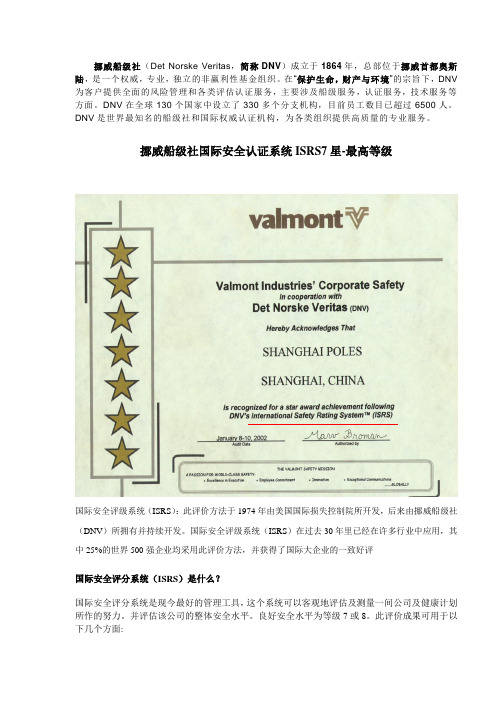
挪威船级社(Det Norske Veritas,简称DNV)成立于1864年,总部位于挪威首都奥斯陆,是一个权威,专业,独立的非赢利性基金组织。
在“保护生命,财产与环境”的宗旨下,DNV 为客户提供全面的风险管理和各类评估认证服务,主要涉及船级服务,认证服务,技术服务等方面。
DNV在全球130个国家中设立了330多个分支机构,目前员工数目已超过6500人。
DNV是世界最知名的船级社和国际权威认证机构,为各类组织提供高质量的专业服务。
挪威船级社国际安全认证系统ISRS7星-最高等级国际安全评级系统(ISRS):此评价方法于1974年由美国国际损失控制院所开发,后来由挪威船级社(DNV)所拥有并持续开发。
国际安全评级系统(ISRS)在过去30年里已经在许多行业中应用,其中25%的世界500强企业均采用此评价方法,并获得了国际大企业的一致好评国际安全评分系统(ISRS)是什么?国际安全评分系统是现今最好的管理工具,这个系统可以客观地评估及测量一间公司及健康计划所作的努力。
并评估该公司的整体安全水平。
良好安全水平为等级7或8。
此评价成果可用于以下几个方面:• 了解公司安全及健康管理与措施的真正安全水平;• 与其它类似企业安全管理水平作个实际比较(Bench marking);• 点出公司安全及健康管理与措施的薄弱环节;• 提出进一步改善公司安全及健康管理的措施;• 跟进后续整改状况及观察真正的安全水平提升等。
ISRS是一套以行为方式基础的系统,从管理结构和审核规程组成,此系统分为二十个单元。
在安全及健康管理上,ISRS是一套有效及十分普遍的系统。
这个系统不单是良好的管理常规,而且可以作为实施、维持及改善安全与健康策略的指引。
国际安全评分系统之计划单元• 领导与管理• 领导人员训练• 定期检查及维修• 关键作业分析及步骤• 事故调查• 工作观察• 紧急应变布置• 作业规章及工作许可证• 事故分析• 知识及技能训练• 个人防护工具• 健康及卫生管理• 评估系统• 工程及转变管理• 个人沟通• 小组会议• 一般宣传• 雇用及配工• 物料及服务管理• 下班后安全挪威船级社的国际质量评价系统IQRS-6级(最高级)。
DNV2.7-1标准

页号3:介绍:该DNV2.7-1近海货物集装箱标准于1989年5月首次出版。
该标准出版的原因是因为当时不管是国际标准、DNV出版的国家规定或是规则均没有特别涵盖近海集装箱。
一份修改说明于已于1995年5月出版。
基本强度和设计要求仍与原始版相同。
许多其它标准、规定适用于集装箱、集装箱类的设备和相关类型的设备。
在起草本标准时,已经考虑到了相关国际标准、规则和规定。
本标准最重要的是IMO (国际海运协会)的MSC/Circ860 和EN12079标准。
在1991年欧洲标准委员会CEN开始为近海集装箱起草一种欧洲标准。
技术委员会CEN TC 280起草了EN12079,该标准已于1999年发行,一份修改版将于2006年出台。
EN12079标准中的近海集装箱的设计、测试和生产要求是直接在DNV标准2.7-1版的基础上而生成的。
本标准与其它标准、规范的关系已在第1.2节中指明了。
本标准已考虑到了各种作为运输设备的近海集装箱,这三种典型的运输有:在岸上由叉车起吊、通过补给船运输、起吊至或是从近海装备上起吊。
本标准包括与所有这三种情况相关的设计要求。
因为近海集装箱频繁被运输和搬运的情况,正常的近海集装箱的易损率通常是十分高的,并经常会出现损坏而需要进行维修。
但,根据此标准集装箱的设计和认证必须具有足够的强度来承受正常的恶劣的近海操作,从而即使遭受到超重荷载的情况也不会完全损坏。
2006年版的变化标准已被大范围地进行了修改,在所有章节中均有变化。
但基本设计和强度要求没有变化,起吊设备除外。
详细的要求、注释和指南已被增加入整个标准和新的附录中。
一些要求也被改变了来与新EN1207标准要求保持一致。
新的材料要求在近海储装箱中进行了介绍,这仅能在某种潜在的气候环境中进行使用。
许多编缉进行了变化,附录编号也被重新进行了编号。
最重要的变化是:第一章已被扩展,包括了详细的可参照的其它集装箱标准和规范。
材料要求被从设计的章节中剔除,移到了一个单独的第三章中。
挪威船级社DNV认证标准译件(全)
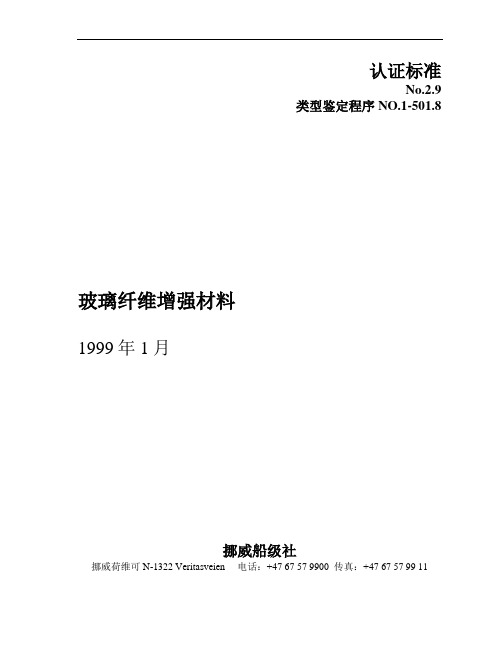
认证标准No.2.9类型鉴定程序 NO.1-501.8玻璃纤维增强材料1999年1月挪威船级社挪威荷维可N-1322 Veritasveien 电话:+47 67 57 9900 传真:+47 67 57 99 11目录1. 服务范围-------------------------------4 4.要求---------------------------------62. 步骤-------------------------------------4 4.1 类型鉴定的依据------------------62.1类型鉴定的申请----------------------4 4.2类型鉴定的范围------------------62.2报价-------------------------------------4 4.3一般要求---------------------------62.3类型鉴定文件评估-------------------4 4.4材料要求---------------------------62.4产品和生产设备的初次检查, 4.5类型试验用层压制品的要求---7包括现场观看类型试验-------------4 4.6装和产品标识要求---------------7 2.5检查报告和类型试验结果的评估--4 5. 附录 A: 玻璃纤维增强材料2.6类型鉴定证书的颁发-----------------4的类型鉴定 -------------------92.7两年后证书保留检查-----------------4 6.附录B:类型鉴定申请表2.8四年后证书更新的申请--------------5 90.01a---------------------------103. 须提交的文件--------------------------57. 附录C:类型鉴定证书3.1 定义--------------------------------------5 20.90a样本--------------------111.服务范围“挪威船级社类型鉴定”是基于ISO/IEC 指南2(1991)的定义:“根据对代表生产的一个产品的一个或多个样品进行系统的检查,鉴定其符合规定的要求”。
DNV_2007_CH_材料与焊接规范

验船师可以要求对从受到影响的试验单元的材料再进行试验。 B 700 复验 701 冲击试验除外,当任何试验的结果不能满足要求时,可以对同一样坯的另两个试样再进行试 验。如果这两个附加试验都令人满意,则试验单元可以接受。 702 当一组三个试样的冲击试验结果不能满足要求时,可以对同一块样坯中所取的三个附加的试 样进行试验,其结果加到前面已取得的结果中形成新的平均值。如果这个新的平均值符合要求并且 不超过两个单个值低于要求平均值,而且其中不超过一个的结果低于规定平均值的 70%,则该试验 单元可以接受。 703 如果从代表一个试验单元的复验获得了令人不满意的结果,则进行试验的抽样产品应拒收。 只要对另两个抽样产品进行的试验取得令人满意的试验结果,试验单元的其余材料可以被接受。 704 当一个试验单元被拒收时,该试验单元的其余抽样产品可以重新单独提交试验,得出满意试 验结果的那些产品可以接受。 705 由生产厂选择,拒收的材料可以在热处理或重新热处理后重新提交,或可以作为其它级别重 新提交,只要规定的试验结果令人满意,则可以接受。 706 如果任何试样由于制备不当失败,出现可见缺陷或(在拉伸试验情况下)由于断裂在相应标 距长度允许范围以外,可将有缺陷的试样报废并用相同类型的附加试样代替。 B 800 目视和无损检测 801 所有成品材料都应有良好的表面质量,并且没有损害材料拟定用途的内部和表面缺陷。否则 材料应该符合后面标准章节的相应具体要求。 B 900 缺陷的修复 901 当发现有不可接受缺陷时,这些缺陷应该通过合适方法清除并按照第 2 章中相应要求修复。 由验船师决定,由于清除缺陷造成的浅划痕或凹坑可以被接受,只要不引起材料强度的明显降低并 且经过适当的修整平滑。 902 缺陷的焊补只能在有关具体要求许可情况下进行。在修复工作开始前,应将焊接修补缺陷材 料的方案提交验船师批准。此方案应包括缺陷位置和相应范围的详细信息。
DNV规范——挪威船级社

- 1、下载文档前请自行甄别文档内容的完整性,平台不提供额外的编辑、内容补充、找答案等附加服务。
- 2、"仅部分预览"的文档,不可在线预览部分如存在完整性等问题,可反馈申请退款(可完整预览的文档不适用该条件!)。
- 3、如文档侵犯您的权益,请联系客服反馈,我们会尽快为您处理(人工客服工作时间:9:00-18:30)。
STANDARD FOR CERTIFICATIONNo. 2.7-1 OFFSHORE CONTAINERSAPRIL 2006D ET N ORSKE V ERITASFOREWORDDET NORSKE VERITAS (DNV) is an autonomous and independent foundation with the objectives of safeguarding life, prop-erty and the environment, at sea and onshore. DNV undertakes classification, certification, and other verification and consultancy services relating to quality of ships, offshore units and installations, and onshore industries worldwide, and carries out research in relation to these functions.Standards for CertificationStandards for Certification (previously Certification Notes) are publications that contain principles, acceptance criteria and prac-tical information related to the Society's consideration of objects, personnel, organisations, services and operations. Standards for Certification also apply as the basis for the issue of certificates and/or declarations that may not necessarily be related to clas-sification.A list of Standards for Certification is found in the latest edition of Pt.0 Ch.1 of the ”Rules for Classification of Ships” and the ”Rules for Classification of High Speed, Light Craft and Naval Surface Craft”.The list of Standards for Certification is also included in the current “Classification Services – Publications” issued by the Soci-ety, which is available on request. All publications may be ordered from the Society’s Web site .Comments may be sent by e-mail to rules@Comprehensive information about DNV and the Society's services is found at the Web site © Det Norske VeritasComputer Typesetting (FM+SGML) by Det Norske VeritasIf any person suffers loss or damage which is proved to have been caused by any negligent act or omission of Det Norske Veritas, then Det Norske Veritas shall pay compensation to such person for his proved direct loss or damage. However, the compensation shall not exceed an amount equal to ten times the fee charged for the service in question, provided that the maximum compen-sation shall never exceed USD 2 million.In this provision "Det Norske Veritas" shall mean the Foundation Det Norske Veritas as well as all its subsidiaries, directors, officers, employees, agents and any other acting on behalf of Det Norske Veritas.April 2006IntroductionThis Standard for Certification was first published in May, 1989 as "DNV Certification note 2.7-1 Offshore Freight Con-tainers". It was prepared because other regulations at the time, whether international codes, national requirements or rules published by Det Norske Veritas, did not specifically cover offshore containers. A revised Certification Note was issued in May 1995. The basic strength and design requirements from the original edition were retained.Many other standards, codes and regulations exist for contain-ers, container-like units and related types of equipment. Inter-national standards, codes and regulations considered relevant have been taken into account when preparing this Standard for Certification. The most important of these are IMO's circular MSC/Circ.860 and EN 12079. In 1991 the European Commit-tee for Standardisation, CEN, started developing a European Standard (EN) on offshore containers. Technical committee CEN TC 280 prepared EN 12079, which was issued in 1999, and a revised edition will be issued in 2006. The requirements for design, testing and production of offshore containers in EN 12079 are directly based on DNV Standard for Certification 2.7-1. The relationship between this Standard for Certification and other standards, codes and regulations is outlined in sub-chapter 1.2.The Standard for Certification is concerned with certification of all types of offshore containers as transport units. The three typical phases of transport are: shoreside (e.g. by fork lift truck), by supply vessel and lifting to and from offshore instal-lations. The Standard for Certification includes design require-ments related to all three phases.Under conditions in which offshore containers are often trans-ported and handled, the "normal" rate of wear and tear is high, and damage necessitating repair will occur. However, contain-ers designed and certified according to this Standard for Certi-fication should have sufficient strength to withstand the normal forces encountered in offshore operations, and not suf-fer complete failure even if subject to more extreme loads.Changes in the 2006 editionThe Standard for Certification has been extensively revised, with changes in all sections. However, the basic design and strength requirements have not been changed, with the excep-tion of lifting sets. Detailed requirements, interpretations and guidances have been added throughout the standard and in the new appendices. Some requirements have been changed to align with the new EN 12079. New material requirements have been introduced for offshore containers that will only be certified for use in temperate climates. Many editorial changes have been made and the Appendices have been renumbered.The most important changes are:—Section 1 has been extended to include detailed references to other container standards and regulations.—The requirements for materials have been taken out of the design section and moved to a separate Section 3.—In the design section (now Section 4) there are several changes and additions, including protection on the top of open containers, allowable stresses in aluminium, clear-ances in padeye holes, requirements for fork pockets, test-ing of long containers with fork lift, and many additional guidances and notes.—In Section 5 (Production) detailed requirements for NDE have been added and the amount of production testing has been reduced.—Section 8 for lifting sets has been extensively revised. Ref-erence standards have been added, a new calculation method has been introduced, detailed requirements for sling and component certificates have been added and the marking tags on lifting slings have been revised.—In Section 9 the schedule for period examination and tests have been changed.— A new Appendix C has been added with guidelines and examples on strength calculations.— A new appendix D has been added with guidance on de-sign and calculations of padeyes.—Appendix E on calculations of lifting sets has been greatly extended.—IMO's circular on offshore containers, MSC/Circ. 860 has been added at Appendix I.—Existing Annexes 1 and 2 will now be included in the same booklet as the rest of the standard.— A new Annex 3 concerning containers for temperate cli-mates has been introduced. Containers certified to Annex3 have higher design temperature than required by the main requirements of this Standard for Certification, but are otherwise identical to standard offshore containers.Consequences:—Existing offshore containers that DNV have been certified according to previous versions of Standard for Certifica-tion 2.7-1 will also comply with the new standard. Re-cer-tification is generally not deemed necessary. However, on some containers the new requirements for lifting sets in Section 8 may give higher requirements for slings and or shackles.—Containers certified to this Standard for Certification will comply with the requirements of MSC/Circ.860.—Containers certified to this Standard for Certification will also comply with the requirements in the new EN12079 parts 1 and 2, and certification to this standard can be in-cluded at no extra cost.April 2006April 2006CONTENTS1.GENERAL (8)1.1Scope (8)1.2Relationship with other standards, codes andregulations (8)1.2.1The International Maritime Organization (IMO) (8)1.2.2ISO standard freight containers (ISO Containers) (8)1.2.3European Standard EN 12079 (8)1.2.4Standard for Certification 2.7-2 – Offshore servicecontainers (8)1.2.5Units for transportation offshore (8)1.2.6Regulations for Lifting Appliances (9)1.3National authorities (9)1.4Definitions (9)1.4.1Offshore container (9)1.4.2Freight container (9)1.4.3Units for transportation offshore (9)1.4.4Permanent equipment (9)1.4.5Primary Structure (9)1.4.6Secondary Structure (10)1.4.7Prototype (10)1.4.8Owner (10)1.4.9Lifting set (10)1.4.10Assembly secured shackle (10)1.5List of symbols (10)2.APPROVAL AND CERTIFICATIONPROCEDURES (10)2.1General (10)2.2Approval (11)2.2.1Approval Schemes (11)2.2.2Approval to other standards (11)2.2.3Documents for approval and information (11)2.2.4Design Review (11)2.3Certification (11)2.3.1Survey and certification (11)2.3.2Testing and inspection (12)2.4Certification of existing containers (12)2.5Maintenance of certificate (12)2.6Summary of procedures (12)2.6.1Procedure for individual (case-by-case) approval andcertification (12)2.6.2Procedure for type approval and certification (12)2.6.3Procedure for design assessment for type approval andcertification (12)3.MATERIALS (13)3.1Steel (13)3.1.1General (13)3.1.2Rolled, forged and cast steels in offshore containerstructures (13)3.2Aluminium (14)3.3Non-metallic materials (14)3.4Material certificates (14)4.DESIGN (14)4.1General (14)4.1.1Structural design (15)4.1.2Stability against tipping (15)4.1.3Protruding parts and top protection (15)4.1.4Design temperature (15)4.2 Structural strength (15)4.2.1Allowable stresses (15)4.2.2Load distribution (16)4.2.3Lifting loads (16)4.2.4Impact loads (16)4.2.5Minimum material thickness............................................174.3Welding (17)4.3.1Welding of padeyes (17)4.3.2Welding of other primary structure (17)4.4Design Details (17)4.4.1Padeyes (17)4.4.2Intermediate cargo decks (17)4.4.3Stacking and stacking fittings (18)4.4.4ISO-corner fittings (18)4.4.5Floor (18)4.4.6Fork lift pockets (18)4.4.7Container walls (18)4.4.8Doors and hatches (18)4.4.9Internal securing points (18)4.4.10Tugger points (19)4.4.11Equipment (19)4.4.12Coating and corrosion protection (19)4.5Tank containers and bulk containers (19)4.5.1Tank containers (19)4.5.2Tank containers for dangerous goods (19)4.5.3Containers for bulk solids (19)4.5.4Bulk Containers for solid dangerous goods (20)4.6Prototype testing (20)4.6.1Introduction (20)4.6.2Test equipment and calibration (20)4.6.3Lifting tests (20)4.6.4Vertical impact test (21)4.6.5Other tests (21)5.PRODUCTION (21)5.1General (21)5.2Primary structure (21)5.2.1Approved Welders (21)5.2.2Welding procedures (22)5.2.3Inspection of welds (22)5.2.4NDE procedures and NDE operators (22)5.3Secondary structure (22)5.4Production testing (22)5.4.1Lifting test (22)5.4.2Weatherproofness testing (23)5.5Production documentation (23)5.6Inspection and certification (23)6.MARKING (23)6.1Safety marking (23)6.2Identification and Certification Markings (24)6.3Information Markings (24)6.4Marking of Lifting Set (24)6.5Other Marking (24)7.PLATING OF CONTAINERS (24)7.1General (24)7.2Data Plate (24)7.3Inspection plate (25)8.LIFTING SETS (25)8.1General requirements (25)8.2Approval and certification of lifting sets (25)8.3Design of lifting sets (25)8.3.1Dimensions and Strength of Lifting Sets (26)8.3.2Lifting set components (27)8.4Materials (27)8.5Certificates for lifting sets and components (28)8.5.1Sling certificates (28)April 20068.5.2Component certificates (28)8.6Marking of lifting sets (28)9.PERIODIC EXAMINATION, TESTS ANDREPAIRS (29)9.1General (29)9.2Inspection, test and repairs on containers (29)9.2.1Schedule of examination and tests (29)9.2.2Visual inspection (29)9.2.3Non-destructive testing (30)9.2.4Repairs and modifications of containers (30)9.2.5Marking of the inspection plate (30)9.3Inspection, test and repairs on lifting sets (30)9.3.1Schedule of examination and tests (30)9.3.2Load testing of chain sling legs (30)9.3.3Non-destructive examination of sling components exceptwire rope legs (30)9.3.4Visual inspection of the lifting set (30)9.3.5Chain and wire rope slings and components (30)9.3.6Shackles (31)9.3.7Marking of the lifting set tag (31)9.4Inspection, test and repairs on tank containers 31 9.5Inspection reports (31)APP. ALIST OF REFERENCES (32)APP. BEXAMPLE OF OFFSHORE CONTAINER (34)APP. CGUIDELINES AND EXAMPLES ON STRENGTH CALCULATIONS (35)APP. DDESIGN OF PADEYE (37)APP. ECALCULATIONS OF LIFTING SETS (38)APP. FEXAMPLE OF DROP TEST (42)APP. GCERTIFICATE FOR OFFSHORE CONTAINER (43)APP. HDNV EMBLEM FOR OFFSHORE CONTAINERS (45)APP. IMSC/CIRC.860 (46)APP. JCERTIFICATE FOR OFFSHORE CONTAINER LIFTING SLINGS – EXAMPLE (51)APP. KCERTIFICATE FOR LIFTING SET COMPONENTS* FOR OFFSHORE CONTAINERS – EXAMPLE (52)ANNEX 1TYPE APPROVAL OF LIFTING SETS FOR OFFSHORE CONTAINERS ...................................531.INTRODUCTION.. (53)2.SCOPE (53)3.GENERAL (53)3.1Documentation to be submitted (53)3.1.1Documentation for type approval of lifting slings (53)3.1.2Documentation for type approval of lifting setcomponents (53)3.1.3General documentation from the manufacturer (53)3.2Validity (53)3.3Renewal (53)4.DESIGN REQUIREMENTS (54)5.MATERIALS AND MATERIAL TESTING (54)6.PROTOTYPE TESTING (54)7.MARKING AND TRACEABILITY (54)8.REQUIREMENTS RELATED TOMANUFACTURERS (54)9.TYPE APPROVAL CERTIFICATE (54)10.PRODUCTION AND CERTIFICATION (55)10.1Production testing (55)10.2Lifting set certificate (55)10.3Certificates for Lifting Set Components (55)ANNEX 2APPROVAL PROGRAMME FOR TEST FACILITIES ENGAGED IN LOAD TESTING AND NDT INSPECTION OF OFFSHORE CONTAINERS (56)1.GENERAL (56)1.1Scope (56)1.2Objective (56)1.3Extent of engagement (56)1.4Validity (56)2.REQUIREMENTS TO SUPPLIER (56)2.1Submission of documents (56)2.2Quality assurance system (56)2.3Qualification of personnel (56)2.4Supervisor (57)2.5Operators (57)2.6Personnel records (57)2.7Equipment (57)2.8Procedures and instructions (57)2.8.1Lifting tests (57)2.8.2Vertical impact test (57)2.8.3Other tests (58)2.8.4Non-destructive examination (58)2.9Administrative procedures (58)2.10Verification (58)2.11Sub-contractors (58)2.12Reporting (58)2.12.1Contents of reports: (58)2.12.2Prototype or production tests (58)2.12.3Tests on existing containers (58)April 20063.REPAIRS ON CONTAINERS IDENTIFIED ASA RESULT OF LOAD TESTS AND OR NDT. 583.1General (58)4.APPROVAL PROCEDURES (58)4.1Review of documentation (58)4.2Initial audit (58)4.3Special procedures related to control of supplier'srelationship with the parent company (58)4.4Certificate of approval (59)4.5Renewal of approval (59)RMATION ON ALTERATION TO THECERTIFIED SERVICEOPERATION SYSTEM (59)5.1Alteration...............................................................596.CANCELLATION OF THE CERTIFICATE OFAPPROVAL (59)6.1Right to cancel (59)6.2Information (59)6.3Re-approval (59)7.REFERENCES (59)ANNEX 3OFFSHORE CONTAINERS FOR USE IN TEMPERATE CLIMATES ONLY (60)1.INTRODUCTION (60)2.AREA (60)3.DESIGN TEMPERATURE (60)4.MARKING (60)5.DATA PLATE (60)April 20061. General1.1 ScopeThis Standard for Certification applies for transport related re-quirements for offshore containers with respect to design, manufacture, testing, certification, marking and periodic in-spection.The Standard for Certification covers the container structure and any permanent equipment for handling, filling, emptying, refrigerating, heating and safety purposes.The intention is that offshore containers shall meet the follow-ing requirements:—Be safe in use with regard to:—lives—environment—hazard to the vessel/installationBe suitable for repeated use through choice of:—material—protection—ease of repair and maintenance.The requirements in this Standard for Certification are based on a number of assumptions regarding the handling and oper-ation of offshore containers:—They are lifted individually by crane hook attached to top link of lifting set—They are not lifted by spreaders or using ISO container fit-tings—They can be lifted anywhere (world wide) by any crane with sufficient capacity and speed—For containers only approved for limited operation area (Temperate Climate) see Annex 3—They are only stacked if they are designed for this.—They are stacked only onshore or on offshore installations.Not to be stacked during transport on ships.—Cargo or loose installations are properly secured in the container.—The container is designed to give adequate protection to its cargo or to installations inside.—They are handled according to IMO’s “Code of safe prac-tice for supply vessels”.—Handling and operation is in accordance with local regula-tions.The Society may approve alternative solutions that are found to represent an overall safety standard equivalent to the re-quirements in this Standard for Certification. Such approval may be revoked if subsequent information indicates that the chosen alternative is not satisfactory.When the word "container" is used throughout the Standard for Certification, it means an offshore container.Use of the word “shall” implies a mandatory requirement when seeking the Society’s approval. Use of the word “should” im-plies a recommended approach, where comparable solution may also be acceptable.The passages throughout this Standard for Certification marked "Guidance" and “Note” are not to be taken as require-ments by Det Norske Veritas. Such Guidance and Notes are in-tended as practical advice and information for the designer, manufacturer or operator.This Standard for Certification often refers directly to various standards (EN, ISO etc.), or to “other recognised standard”. Recognised standard means a standard found acceptable by the Society.1.2 Relationship with other standards, codes and regulations1.2.1 The International Maritime Organization (IMO) IMO has issued both the International Convention for Safe Containers, CSC, and the International Maritime Dangerous Goods code, IMDG. Both of these are mandatory international regulations. IMO has recognised that the CSC convention is not directly applicable for offshore containers that are handled in open seas, and has issued a circular (MSC/Circ.860) with guidelines on certification of offshore containers. The IMDG code also requires that containers and portable tanks that are handled in open seas should be certified for this purpose. Containers certified to this Standard for Certification also comply with MSC/Circ.860, and this will be referenced in the certificates. The circular is reproduced at Appendix I.IMO has also issued the Code of safe practice for the carriage of cargoes and persons by offshore supply vessels (OSV code) which includes guidelines for handling, stowage and securing of cargoes.1.2.2 ISO standard freight containers (ISO Containers) Containers that are intended for sea transport on container ships are normally designed according to an applicable part of ISO 1496. Containers that are certified to CSC are in general also designed as ISO containers.Offshore containers designed and certified according to this Standard for Certification can also be designed and certified according to CSC And ISO 1496.1.2.3 European Standard EN 12079(At date of writing: new version only available as prEN 12079) The European Standard EN 12079 “Offshore containers and associated lifting sets” consists of 3 parts, see Table 1-1.Offshore Containers and lifting sets certified to this Standard for Certification also comply fully with prEN12079 parts 1 and 2 respectively, and this may be referenced in the certificates.1.2.4 Standard for Certification 2.7-2 – Offshore service containersWhen an offshore container is designed and equipped to be placed onboard a fixed or floating offshore installation to per-form specific services, it may be subject to regulations apply-ing on the installation and to the area where it is placed. Standard for Certification 2.7-2 “Offshore Service Containers”covers containers designed for such requirements.1.2.5 Units for transportation offshoreMany portable units intended for offshore use are not contain-ers as defined in this Standard for Certification. However, there is often a need for verification and certification of such units. DNV has therefore prepared a new Standard for Certifi-cation 2.7-3 for Portable Offshore Units with requirements for design, manufacture, testing etc. for portable units up to 50 000 kg.Offshore Units certified to that Standard for Certification are not intended to carry cargoes as their primary function, but Table 1-1EN 12079part:Title Equivalent sections inStandard forCertification 2.7-1Part 1Offshore containers –design, manufacture andmarkingSec. 1, 3, 4, 5, 6, 7Part 2Lifting sets – Design,manufacture and markingSec. 8Part 3Periodic inspection,examination and testingSec. 9April 2006may carry loose equipment that is related to their intended service.The main difference between Offshore containers and “Units for transportation offshore” is: For such units, their fitness for use must be assessed for each design type, and may have to be considered for each transport event. Operational restrictions may be given in the certificate, or it may be required that the operator evaluate their suitability for each event.1.2.6 Regulations for Lifting AppliancesOffshore containers are not lifting equipment as defined by ILO, by the European Community’s Machinery Directive or by DNV’s Rules for Certification of Lifting Appliances. In-stead they are considered to be cargo units as defined in these codes and directives.However, requirements from these regulations and standards have been taken into account in the requirements in this Stand-ard for Certification, e.g. in the intervals for periodic surveys.1.3 National authoritiesIn cases where National Authorities have stricter requirements than this Standard for Certification, these may be incorporated in the certification procedures.Note:Some National Authorities may consider offshore containers to be lifting equipment.---e-n-d---of---N-o-t-e---1.4 Definitions1.4.1 Offshore containerAn offshore container is a portable unit with a maximum gross mass not exceeding 25 000 kg, for repeated use in the transport of goods or equipment, handled in open seas, to, from or be-tween fixed and/or floating installations and ships.An offshore container comprises permanently installed equip-ment, see 1.4.4.Note:Other permanent or loose equipment will not be covered by the certification unless specially agreed. However, supporting struc-ture for heavy equipment, machinery, etc. will be approved ac-cording to 4.4.11.---e-n-d---of---N-o-t-e---Offshore containers are also defined by the requirements throughout this Standard for Certification. Refer to definitions of primary and secondary structure below and in 4.1.Units for offshore lifting that are intended for installation and not for repeated transport are not considered to be containers. Likewise, units that do not have an outer framework with padeyes are not considered to be containers. Hence, these units are not covered by Standard for Certification 2.7-1. (See how-ever the definition of waste skip in 1.2.2.) Many such portable units may be eligible for certification according to DNV’s Standard for Certification for Portable Offshore Units1. Offshore containers may be divided into 3 main categories: a)Offshore freight container:Offshore container built for the transport of goods. Exam-ples of offshore freight containers:—general cargo container: a closed container with doors —cargo basket: an open top container for general or spe-cial cargo (e.g. pipes, risers)—tank container: a container for transport of dangerous or non-dangerous fluids—bulk container; container for transport of solids in bulk—special container; container for transport of special cargo (e.g. garbage compactors, equipment boxes,bottle racks).b)Offshore service container:Offshore container built and equipped for a special service task, mainly as temporary installation. (Examples are, lab-oratories, workshop, stores, power plants, control stations, wireline units).c)Offshore waste skipAn open or closed offshore container used for the storage and removal of waste. Normally constructed from flat steel plates forming the load bearing sections of the con-tainer, bracing in the form of steel profiles, e.g. channel or hollow section, being fitted horizontally around sides and ends. Waste skips may be open or have loose or hinged coversIn addition to the pad eyes for the lifting set these contain-ers may also have side mounted lugs suitable for attach-ment of the lifting equipment mounted on a skip lift vehicle.1.4.2 Freight containerRe-usable transport container, used for international traffic and designed to facilitate the carriage of goods by one or more modes of transport (including marine) without intermediate re-loading. See DNV "Rules for Certification of Freight Contain-ers, 1981". Also known as CSC Containers or ISO Containers.1.4.3 Units for transportation offshorePortable unit or package with a maximum gross mass not ex-ceeding 50 000 kg, for repeated or single use with a primary service function, handled in open seas, to, from or between fixed and/or floating offshore installations and ships. Units of this type are not considered to be offshore containers.1.4.4 Permanent equipmentEquipment that is attached to the container and which is not cargo.Note:May include lifting sets, additional fittings for handling and se-curing, filling, emptying, cooling and heating, intermediate decks, securing points, garbage compactors, etc.---e-n-d---of---N-o-t-e---1.4.5 Primary StructureLoad carrying and supporting frames and load carrying panels. Primary structure includes the following structural compo-nents:—Load carrying and supporting frames—Load carrying panels (floor, ‘tweendecks)—Fork lift pockets—Pad eyes—Supporting structures for tanks—Supports for heavy equipment—Corner/knee brackets.Primary structure is divided into two sub-groups:a)Essential and non-redundant primary structure are themain structural elements which transfer the resulting cargo load to the crane hook or fork lift truck (i.e. forming the load path from the payload to the lifting sling), and will at least include:—top and bottom side rails—top and bottom end rails—corner posts—pad eyesApril 2006—fork lift pockets.Other primary structure may also be considered essential and or non-redundant.b)Non-essential primary structure are e.g. floor plates andother structural elements for which the main function is other than described in a). Deflector plates, stacking fit-tings and end plates on hollow section are considered to be in this category. This sub-group also includes protective frame members.Side and roof panels (including corrugated panels) are not con-sidered to be part of the primary structure and shall not be tak-en into account when evaluating the strength of the container. For waste skips the requirements in 4.1.1 apply.1.4.6 Secondary StructureParts that are not considered as load carrying for the purposes of the design calculations. Secondary structure includes the following components:—Doors, wall and roof panels, covers on skids—Panel stiffeners and corrugations—Structural components used for tank protection only —Internal securing points1.4.7 PrototypeAn equipment item, considered to be representative for the production and the product to be approved, used for prototype testing. The prototype may either be manufactured especially for type testing or selected at random from a production series. If manufactured specially, it is expected that the tools and the production process are comparable to those to be used for sub-sequent production.1.4.8 OwnerThe legal owner of the offshore container or a delegated nom-inee.1.4.9 Lifting setItems of integrated lifting equipment used to connect the off-shore container to the lifting appliance. This can comprise sin-gle or multi leg slings (with or without a top leg) and shackles, whether assembly secured or not.1.4.10 Assembly secured shackleShackle fitted to a sling leg and secured by a seal or similar de-vice, so as to signal, unambiguously, whether or not the shack-le has been exchanged.Note 1:Shackles that are captive in the thimbles are also considered as assembly secured.---e-n-d---of---N-o-t-e---Note 2:Shackles that are assembly secured, i.e. can not be separated from the lifting sling, are considered to be part of the lifting sling.See 9.3.---e-n-d---of---N-o-t-e---1.5 List of symbolsR=Rating or maximum gross mass of the offshore con-tainer including permanent equipment and its cargo,in kg; but excluding the lifting setNote:The mass of the lifting set is not included in R because the lifting set is often not available at the time of certification and because it may be replaced during the lifetime of the container.---e-n-d---of---N-o-t-e---T=Tare mass. Mass of the empty container including any permanent equipment but excluding cargo andlifting set, in kg;P=Payload. The maximum permissible mass of cargo which may safely be transported by the container, inkg. (P = R-T)S =The mass of the lifting setF =Design load, in NL =Length of container, in mmR e=Specified minimum yield stress at room tempera-ture, in N/mm2.R m=Specified minimum tensile strength at room tem-perature, in N/mm2.R p 0.2=0.2% proof stress at room temperature, in N/mm2. RSL =Resulting Sling Load on padeyes, in N.T D=The design temperature is a reference temperature used for the selection of steel grades used in off-shore containers and equipment.g =Standard acceleration of gravity (~ 9.81 m/s2).l n=Nominal length of structural member, in mmn =Number of sling legst =Material thickness, in mm.v =Angle of sling leg from vertical in degreesy =Deflection of structural member, in mmσe=The von Mises equivalent stress, in N/mm2.Ψ =Load factorWLL =Working Load Limit, in tonnes. Maximum mass that a lifting component is authorized to sustain inlifting serviceNote 1:The WLL for lifting components that is specified in standards, product specifications, etc. is normally the WLL for general lift-ing service. For the special application of lifting sets fitted to off-shore containers, the WLL is enhanced as described in Section.8.---e-n-d---of---N-o-t-e---Note 2:The term "Safe Working Load, SWL" is not used in this Standard for Certification. This term is not clearly defined for containers and should, therefore not be used when referring to offshore con-tainers. The term “Working Load Limit, WLL” is only used for lifting sets, not for containers.---e-n-d---of---N-o-t-e---2. Approval and Certification Procedures 2.1 GeneralOffshore containers designed, manufactured, tested and marked in compliance with the following requirements may be certified by Det Norske Veritas. At the end of the verification process a product certificate is issued by the Society and the Society's numbered certification emblem is affixed to the con-tainer.Certification consists of the following steps:—Design review—Inspection and testing of prototype—Production inspection and testing—Issuance of certificatesAn application for approval and certification should be sent to the local DNV office who will forward this to the approval of-。
